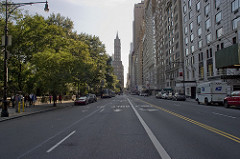A new paper just came out from Dunn et al about how urban stress effects microbial communities in Manhattan. Urban structures can provide barriers to species movement and create islands of life, both for macro- and microscopic creatures. Here, they sampled soil bacterial and fungal species, as well as ant communities, from small road medians and large parks to compare the effects of urban stress.
In ants (macro), they found that both species richness and composition differed between the two habitats, and there were fewer ant species in medians than in parks. On the other hand, soil bacteria only differed in composition between the two habitats. Richness was the same between both medians and parks for bacteria. Fungi showed a slight trend towards less species richness in medians but this was not statistically different in other analyses. Interestingly enough, they also tested to see if plant-associated fungi could account for the missing fungal species in medians, and they did not. Fungal and ant species richness also increased with habitat size , whereas bacterial richness did not.

These results show that conservation efforts in urban areas will have different effects on different kinds of creatures, both macro- and microscopic. Therefore, the goals of such conservation would be different depending on what you want to save. If the aim is to save ants, then more parks might need to be built, or more plants put into medians. If bacteria are to be saved, we should focus more on a certain composition of their community rather than just increasing their habitat area, since this would not help. An additional human health aspect for this is that humans have greater psychological benefits from more species rich greenspaces than those with less. Since an increasing number of people are choosing to live in urban areas, our infrastructure and city planning needs to keep up with findings such as these and put them into practice. Hopefully we can look to a greener (literally) urban setting for the future!